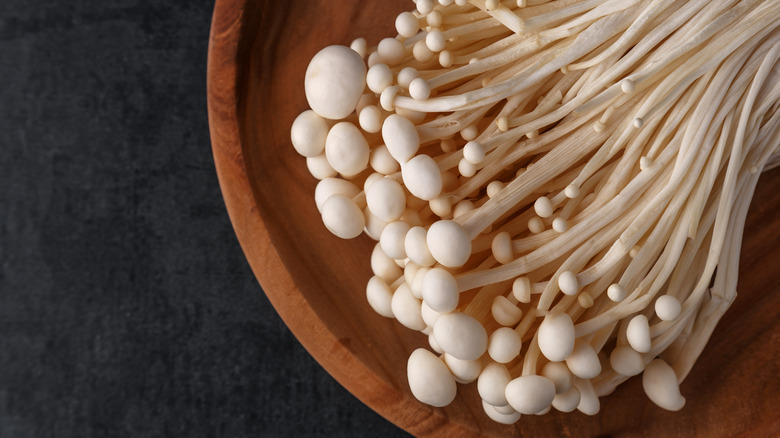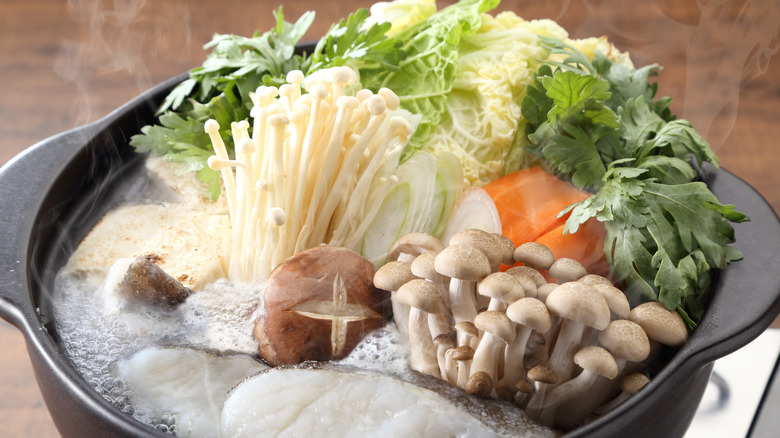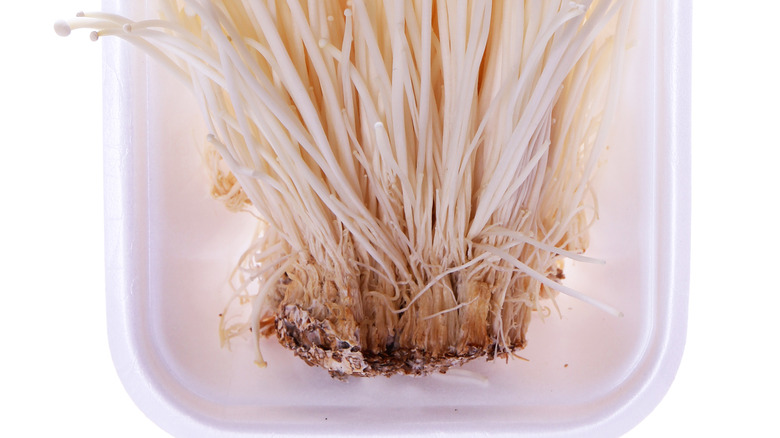Why It's Important To Remove The Base Of Enoki Mushrooms
Enoki mushrooms are quite popular. In fact, they're the fifth most-produced mushroom in the world, according to Nutritious Mushrooms. They're known as long, thin, and white mushrooms and are found throughout Britain, Ireland, North Africa, East Asia, and North America. In the wild, enoki mushrooms have large, flame-colored caps and grow on deadwood and tree stumps. The enoki mushrooms are called by other names too, such as velvet foot, velvet stem, velvet shank, or winter mushroom.
The cultivated enoki mushrooms originate from Japan, but due to their popularity, they're cultivated all over the globe and are widely available, per Nutritious Mushrooms. In fact, the name "enoki" comes from the Japanese enokitake. Keep in mind, the cultivated type is also known as the lily mushroom, futu mushroom, or golden needle mushroom. But regardless of the name used, the tasty mushroom grows in stems and has a stringy, chewy, and crunchy texture that is healthy and beneficial.
The numerous health benefits of enoki mushrooms
Enoki mushrooms are versatile and are an easy add-on to soups, curries, and stews, according to Nutrition Advance. They can be eaten raw and their unique, crunchy texture may also make them the perfect candidate to provide an autonomous sensory meridian response (ASMR) cooking experience (via Natural Kitchen Cooking School). There are also numerous benefits to be reaped from enjoying enoki mushrooms (per Nutrition Advance). For starters, they are low in calories and contain amino acids, like ergothioneine, which aids in the prevention of oxidative stress and free radical damage.
Additionally, consuming enoki mushrooms gives your body immune-boosting benefits since they have anti-inflammatory and anti-viral properties, which can help your body defend itself from unwanted diseases. In fact, a 2016 report states that eating enoki mushrooms could promote anti-cancer and anti-tumor activity (via National Library of Medicine).
As another bonus? These zero-cholesterol, umami-flavored mushrooms contain vitamins and minerals, like thiamine, niacin, riboflavin, pantothenic acid, folate, choline, and vitamins B6, D, E, and K (per WebMD).
Removing the stems of enoki mushrooms
Enoki mushrooms are usually easy to find at grocery stores in the U.S., per Instacart, and usually come in a sealed plastic package, with stems and all. However, these cultivated enoki mushrooms also include the base, which is where all of the stems are clumped together, usually with some dirt as well.
While other mushrooms, like cremini and portobello (these two mushrooms have quite a bit in common, but there are some differences, too) taste better with their woody stems removed, it is not necessary to completely remove the stems of enoki mushrooms, per America's Test Kitchen. Instead, after first removing the plastic packaging, you should cut off the base to get rid of any individual fronds and shake off the loose dirt, giving the enoki a quick rinse to separate the stems and avoid clumping.
"It's easy, you want to keep the clean part only," Jennifer Julien explained in a video shared to Youtube.


